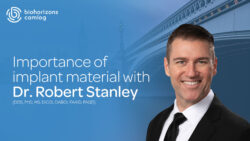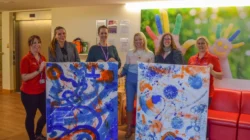Values-based selling – how to communicate effectively with patients about implant dentistry

Dr Barry Oulton – the confident dentist – discusses effective patient communication techniques for the whole team
How many times have you heard or read that effective communication is the key to success? Most of us think we are already good at communicating and that when it doesn’t quite ‘go to plan’, it’s the other person’s fault for not understanding us. This can be the case when you are wanting patients to understand the value of implants, rather than the cost! If we connect with our patients and find out the ‘real’ reason for them wanting our help, it’s an effortless dance.
The answer to world-class communication and sales lies in one little and yet powerful word – ‘rapport’ – the most important and successful place to be when communicating with someone. Being in rapport is something that we very often do without realising. It’s what has happened when you meet someone for the first time and think, ‘it’s like I’ve known them for years.’
A Bonding Exercise
Becoming consciously aware of how to build rapport with anyone you wish to communicate with is an incredibly beneficial skill to learn. Rapport is the glue that brings people together and lack of rapport is what can leave you unstuck or in the ‘Crapport’!
Let me put it another way _ people who like each other tend to be like each other! People like others who are like them, people buy from people they like. And, after all we are in sales so isn’t it key to our success to have patients buy from us?
Consider some of the relationships you have had throughout your life and the chances are that what initially created the bond was something you had in common with the other person. Once you have found a common interest, you will often unconsciously begin to adopt the same use of physiology, gestures, and choice of words. The powerful thing to understand is that you can do this consciously by matching certain behaviours of the other person.
Elements you can match include:
- Body posture – be similar to the other person. Be mindful and take care, people don’t like to be mimicked so you must do this subtly. Matching the angle of their spine works well and is not obvious.
- Their voice – match tone, speed, pitch and volume.
- Key words – if a word is used commonly, such as ‘basically’, you may want to use it in your sentences. E.g., Patient: ‘Basically, I don’t like this gap.’ Dentist: ‘Okay well, basically there are 3 options to you for filling that gap you don’t like’.
- Breathing – match their breathing rate, depth, position.
- Information – the amount of this you give. For example, if someone likes to deal with the big picture, they often find details irritating, so you need to communicate just the big picture. Conversely, someone who needs ALL the information will not buy from you if you only present the big picture.
- Experience – find common ground and show a genuine interest.
As well as matching, there is also crossover matching, in which you can match someone’s gestures with a different part of your body. People do things they are almost unaware of like scratching their chin, flicking their hair and crossing their legs; you can crossmatch this subtly by some equally natural-looking movement like tapping a pencil or jiggling your foot or crossing your arms.
A Meeting of Minds
How will you know that you are in rapport? There’s no secret formula, yet you will know that you are in rapport because you will feel it by having a sense of being in sync with another person. You will feel comfortable and conversation will flow. On the other hand, you will also know when you lose rapport because you will feel uncomfortable and the conversation may be difficult. The good news is that you can simply match the other person’s behaviour very quickly and get back into rapport easily.
Our communication with others can be categorised as the words that we use, the tonality of the words and our physiology – body language. Although not entirely accurate in all situations, psychologist Albert Mehrabian’s ground-breaking communication model tells us that only 7% of our communication is provided by our words. That means that the other 93% of our communication is from our body and tonality (non-verbal). Things like posture, gestures, facial expressions, blinking and breathing, as well as voice tone, tempo, timbre and volume.
By becoming aware of these non-verbal elements of your communication, you can achieve much better outcomes in terms of patients choosing the best treatment options as opposed to the cheapest (assuming they are not one and the same thing)!
As a young boy I thought that selling was a dirty word and salesmen were pushy, unpleasant manipulative people. Little did I know that the word ‘sell’ comes from the Norwegian word ‘selje’, which means ‘to serve’. My responsibility is to serve my patients and, by understanding them, I can serve them better. You can too.
Influencing for Success
The integral elements of rapport-building covered in this article will influence each patient to think unconsciously that you are like them, which, in turn, can create a sense of liking. It is human nature for us to like people who are like us, to buy from people we like, and we do not complain about people we like. So, rapport building is an essential part of effective communication, sales and handling patient concerns.
Once in rapport, it’s important to find out the ‘real’ reason your patient wants your services. No one ‘wants’ an implant, they desire what they think the benefits of the implant will bring them. This is often a mixture of something they don’t want such as embarrassment, rejection and of something that they do want such as social acceptance, connection, confidence. By finding out their deeper motivation (whilst in rapport), we are better positioned to truly serve our patients.
Discover more about BioHorizons Camlog business solutions at www.theimplantrevolution.co.uk









